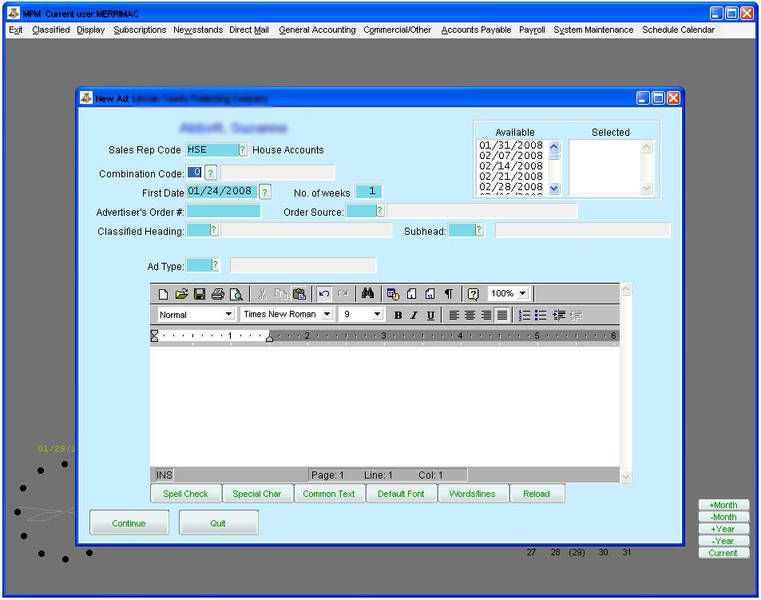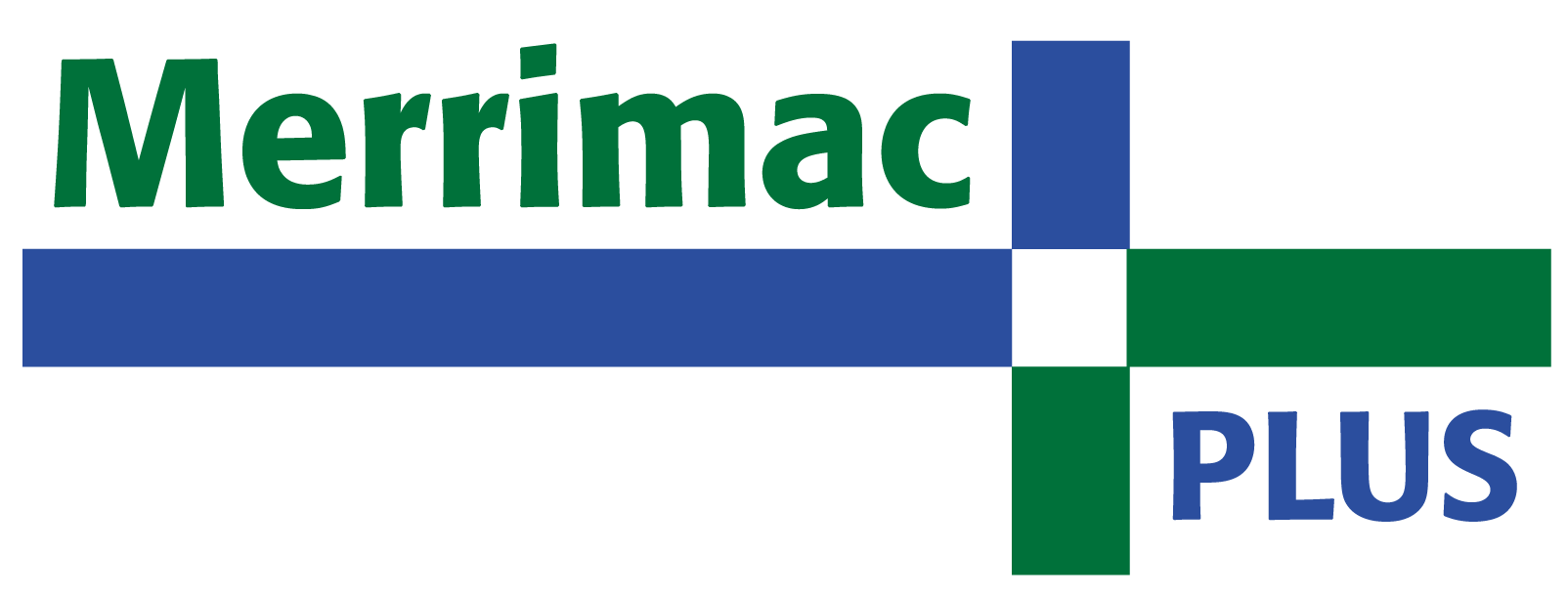
The MerrimacPlus Classified Advertising System is designed to be used by salespeople entering ads directly from telephone or walk-in orders. This portion of the MerrimacPlus program shares many of the characteristics of the MerrimacPlus Display Advertising System, while offering a number of additional features specific to the requirements of classified advertising.
MerrimacPlus automatically calculates classified ad charges based on the number of insertions and the number of words, lines, or column inches; automatically adds charges for blind boxes, voice-mail boxes, bold headlines, etc. (if these are included in the copy); and displays the charges immediately on the screen. The salesperson can then edit the copy, if necessary, to arrive at a desired word or line count.
At press time, a complete copy management system sends a formatted galley to your typesetting or pagination equipment with all classified ads for that issue sorted by heading (and subheading, if used).
Although the Merrimac Publishing Manager is a PC-based system, output can be sent to a variety of Macintosh-based systems including Quark Xpress and InDesign.
The MerrimacPlus classified system also offers the option of advance billing. Bills can be generated on a daily basis as orders are taken, and unpaid ads can automatically be withheld from the paper until payment is received. This feature is also useful for long-run or “TFN” advertisers who pay a month or two in advance.
All invoices and statements contain a complete description of all current and past-due items. No lump-sum “Previous Balance” is ever shown. Items on which partial payment has been made show the total charge for the item followed by the date and amount of the payment(s) applied. Paid-in-full items are shown only if both the charge and the payment occurred in the same billing period, as in the case of a prepaid ad. Otherwise, no zero-balance invoices or statements are generated.
A late-payment service charge can be automatically added at the publisher’s option. Individual advertisers can be blocked from having the late charge added to their bills. Unpaid service charges appear on the advertiser’s record and on subsequent statements as separate line items, so they can be easily changed or canceled.
Advertisers who run on a trade-for-goods/services basis can be identified and their billing and receivables kept separate from cash advertisers’. Trade advertisers receive a statement each month showing their account status and clearly labeled “TRADE BALANCE – DO NOT PAY” or “TRADE CREDIT.” Trade revenue and receivables are kept in separate general ledger accounts from cash revenue and receivables.
Extra charges for such things as blind boxes or boldface type can automatically be included. Any price can be overridden for a single transaction, depending on the operator’s password level.
All entries are checked for possible duplication and the operator is given the choice of canceling the previous entry, canceling the current entry, or allowing both entries to stand.
Payment information can be entered if a payment has been received, or if a credit card number has been taken over the phone. Two credit checks are performed, and the operator is alerted if a) the current entry (minus any payments) brings the advertiser over a pre-assigned credit limit, or b) the advertiser has an outstanding balance more than X days old, where X is a limit assigned by the publisher.
The privilege of over-riding either of these credit checks depends on the operator’s password level. New advertiser and agency records can be set up while using the order entry program, eliminating the need to exit and run one or more separate programs.
MerrimacPlus automatically calculates classified ad charges based on the number of insertions and the number of words, lines, or column inches; automatically adds charges for blind boxes, voice-mail boxes, bold headlines, etc. (if these are included in the copy); and displays the charges immediately on the screen. The salesperson can then edit the copy, if necessary, to arrive at a desired word or line count.
At press time, a complete copy management system sends a formatted galley to your typesetting or pagination equipment with all classified ads for that issue sorted by heading (and subheading, if used).
Although the Merrimac Publishing Manager is a PC-based system, output can be sent to a variety of Macintosh-based systems including Quark Xpress and InDesign.
Billing
Billing is generated automatically from classified advertising orders entered. Advertisers can receive an invoice for every issue and a statement at the end of the month, or just one summary invoice/statement at the end of the month. This choice can be made individually for each advertiser. Monthly statements and invoice/statements show the aging of the account.The MerrimacPlus classified system also offers the option of advance billing. Bills can be generated on a daily basis as orders are taken, and unpaid ads can automatically be withheld from the paper until payment is received. This feature is also useful for long-run or “TFN” advertisers who pay a month or two in advance.
All invoices and statements contain a complete description of all current and past-due items. No lump-sum “Previous Balance” is ever shown. Items on which partial payment has been made show the total charge for the item followed by the date and amount of the payment(s) applied. Paid-in-full items are shown only if both the charge and the payment occurred in the same billing period, as in the case of a prepaid ad. Otherwise, no zero-balance invoices or statements are generated.
A late-payment service charge can be automatically added at the publisher’s option. Individual advertisers can be blocked from having the late charge added to their bills. Unpaid service charges appear on the advertiser’s record and on subsequent statements as separate line items, so they can be easily changed or canceled.
Advertisers who run on a trade-for-goods/services basis can be identified and their billing and receivables kept separate from cash advertisers’. Trade advertisers receive a statement each month showing their account status and clearly labeled “TRADE BALANCE – DO NOT PAY” or “TRADE CREDIT.” Trade revenue and receivables are kept in separate general ledger accounts from cash revenue and receivables.
Copy Management
The Classified System automatically keeps track of the next available issue for scheduling ads. Once ad copy has been sent to the typesetter, the date can be advanced so that future sales will be booked into the next issue. If ads are sold into multiple publications with different closing times, the dates of the individual publications can be advanced, and the system will automatically assign the correct starting date to each publication in the group.Entering New Orders
Classified ads entered through the MPM system are organized by heading, subheading (if used), type (line ad, boxed ad, voice-mail, etc.), and order source. Orders are automatically credited to the appropriate sales rep. Up to one year’s worth of insertions can be entered as a single transaction, provided the copy is the same for all insertions. Pricing is based on the type of ad, length of run, and on word count, line count, or column inches.Extra charges for such things as blind boxes or boldface type can automatically be included. Any price can be overridden for a single transaction, depending on the operator’s password level.
All entries are checked for possible duplication and the operator is given the choice of canceling the previous entry, canceling the current entry, or allowing both entries to stand.
Payment information can be entered if a payment has been received, or if a credit card number has been taken over the phone. Two credit checks are performed, and the operator is alerted if a) the current entry (minus any payments) brings the advertiser over a pre-assigned credit limit, or b) the advertiser has an outstanding balance more than X days old, where X is a limit assigned by the publisher.
The privilege of over-riding either of these credit checks depends on the operator’s password level. New advertiser and agency records can be set up while using the order entry program, eliminating the need to exit and run one or more separate programs.
Extend / Renew Previous Orders
Ads that have previously run can be recalled and run for an additional period of time. Copy or classification changes can be made during this operation and pricing will be recalculated. Payment information can also be entered, and credit and duplication checks are performed as for new orders.Sales Reports
All sales reports can be printed for any specified time period and can optionally include any specified comparison period. Advertisers are listed individually with their activity in inches, pages and net billing for each of the time periods specified. When a comparison period is requested, a third set of figures showing the net change for each advertiser is also printed. Totals are shown for each period and for the net change. Most reports then produce a summary for each sorting category (business classification, salesperson, section, etc.).
